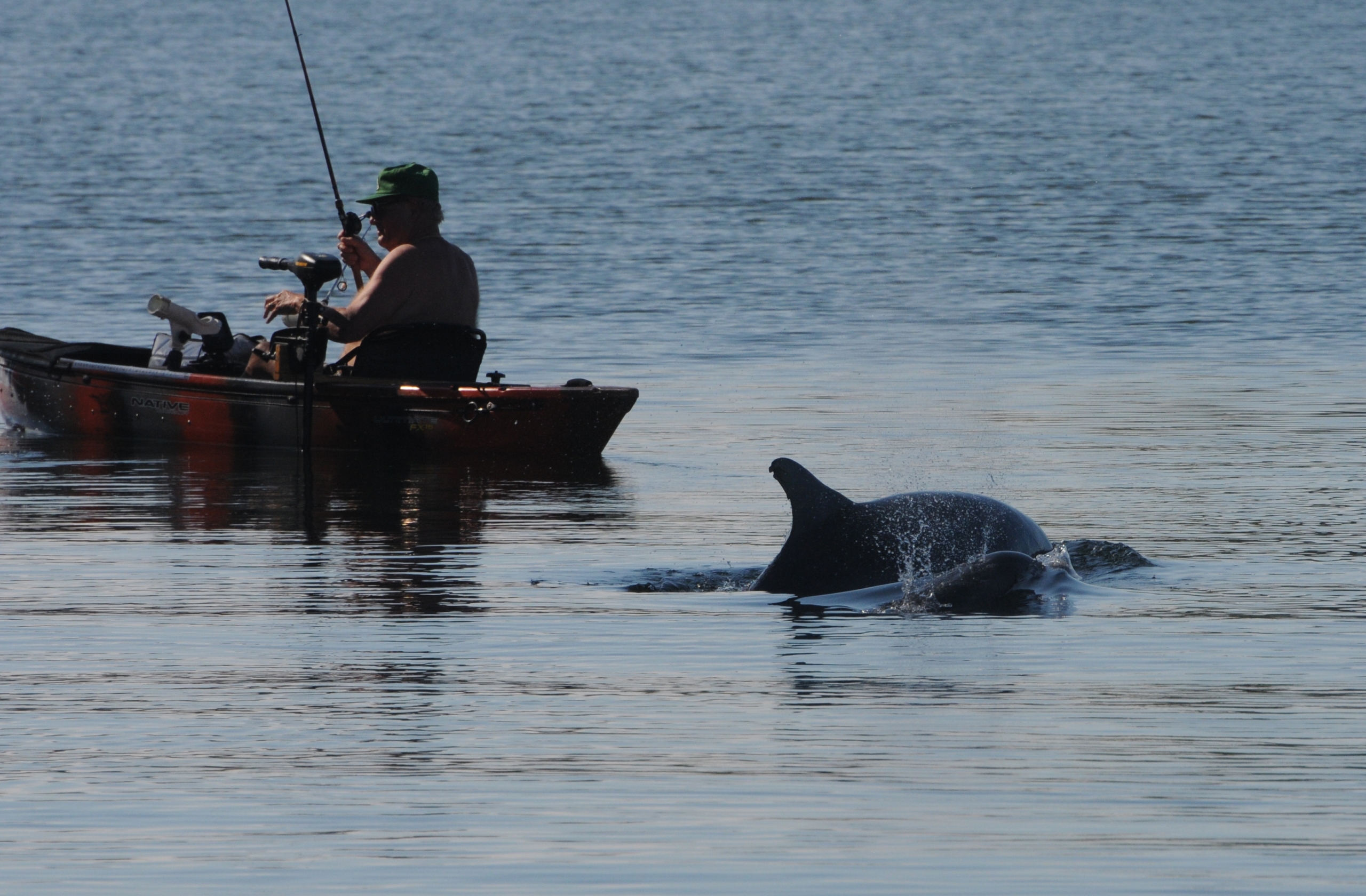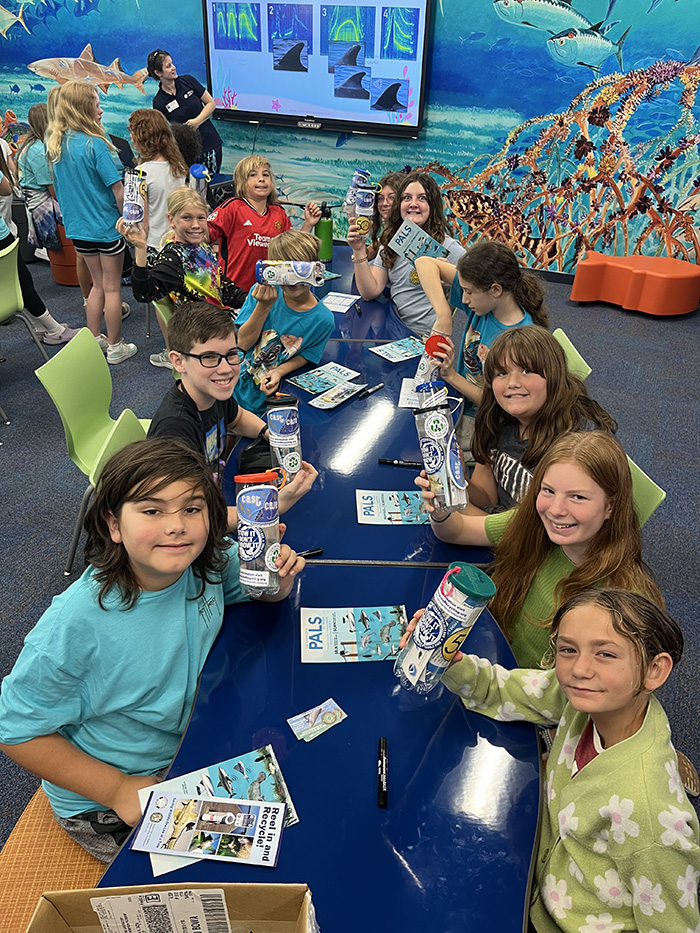Be a Dolphin-Friendly Angler

Over time, we’ve learned much about dolphin lives and how they spend their time in the wild. We’ve also learned much about how their lives end, both from natural causes and from anthropogenic factors — that is, factors that are caused by human activities.
Entanglement in discarded fishing gear is one of the leading causes of anthropogenic dolphin deaths and injuries in the wild dolphin population that we study, and over the course of our program, we’ve rescued dozens of dolphins that have become entangled in fishing gear. (Other human-related causes of death and injury include boat/propeller strikes, illegally feeding wild dolphins, and environmental contaminants.)
We’ve seen three types of interactions between anglers and dolphins increase:
- Scavenging: Dolphins take fish or bait discarded by anglers in boats or on piers. Instead of eating wild-caught prey, dolphins develop the bad habit of approaching humans.
- Depredation: Dolphins remove caught-fish from fishing lines. This puts the dolphin too close to the hook(s) that caught the fish and can lead to the dolphins getting hooked or injured themselves.
- Entangling: Dolphins can become entangled in discarded fishing line, restricting their movements, ability or fish or even escape predators. Entanglements can lead to cuts, skin sores, infection, and even death.
The good news is that you can easily help prevent dolphin injuries and deaths!
All you have to do is follow a few simple tips:
- Never feed wild dolphins or discard bait when dolphins are nearby.
- Reel in your fishing line if dolphins appear.
- Change locations if dolphins show interest in bait or catch.
- Release catch quietly away from dolphins when and where it is possible to do so without violating any state or federal fishing regulations.
- Check gear and terminal tackle to make sure it won’t break off easily and, if your line does break, be sure to collect anything left behind in mangroves or on docks.
- Use circle and corrodible hooks and avoid braided fishing line.
- Stay at least 50 yards away.
- Stash your trash in a lidded container on your boat until you can get to shore and dispose of it safely in a place where it will not blow back into the water. (An old tennis-ball can with a lid is perfect for stashing used line until you return to shore.)
Stow It, Don’t Throw It!
Did you know that monofilament fishing line can take up to 600 years to decompose and that it takes even longer for braided fishing line to break down in the environment?
More than a decade ago, scientists from SDRP and Mote Marine Laboratory helped to create “Stow It, Don’t Throw It,” a youth-driven marine debris prevention and ocean conservation program with the goal of helping to ensure that fishing line is disposed of properly.
The kids in the program designed “personal monofilament collectors” where anglers could stash their used line until it could be disposed of properly in a closed container onshore. They gave hundreds out at fishing tournaments and other events.
Anglers of all ages can follow their lead. It’s easy!
Just find an old tennis ball can with a lid, decorate it to your heart’s content, and stow it on your boat (be sure to weight it down or attach it to the boat so it won’t blow away). Then, if you need to strip your line, you’ll have a handy place to stash it until you get back to shore!
Unfortunately, unlike monofilament, braided line can’t be recycled and it is much more damaging to dolphin tissues, cutting through like a sawblade, so please take that into consideration while you’re fishing.

More than 25 million people enjoy recreational fishing in the United States, often in the same waters where wild dolphins live. This overlap creates the potential for dolphins to develop abnormal behaviors and to be injured or harmed from boats and/or fishing gear. Dolphins like Vespa, who is featured in this video, have learned that they can get an easy meal by stealing bait from fishermen, eating their discarded catch, or begging for food directly. Unfortunately, Vespa’s children and grandchildren have learned many of these unnatural and dangerous behaviors, putting them all at risk. Sadly, Vespa’s 7th calf, who was observed patrolling for food near piers and fishing boats with his mother, died after becoming entangled five different times in fishing line.
1.4 billion pounds of human trash enters the ocean every year, harming thousands of marine animals. Items such as plastic bags, balloons, and fishing line can be accidentally eaten or become wrapped around an animal’s body causing injury or death. Dolphins in coastal regions such as Sarasota Bay, Florida, are impacted by a variety of — sometimes bizarre! — debris items. For example, Scrappy, the dolphin featured in this video, was found with a men’s bathing suit wrapped around his body that was cutting deeply into his flippers, threatening his life. Fortunately, we were able to remove the bathing suit, saving him from further harm. We continue to see Scrappy in the wild and he appears to be in good health. But success stories like Scrappy’s are rare, and other marine animals eating or getting entangled often suffer terrible deaths.
Every 6 minutes a power boat passes by dolphins in Sarasota Bay, Florida. This repeated disturbance can interrupt dolphin behavior and boat collisions have the potential to cause injury or death. Pumpkin and her family are some of the dolphins that have been affected by boats in this area. In 1996, Pumpkin was hit by a boat propeller while swimming with her year-old calf named Pi. The propeller cut deeply into her dorsal fin and she became separated from young Pi for several days. A few years later, Pi and his buddy Noah were also hit by boats, leaving minor injuries on Pi’s dorsal fin and deep cuts along Noah’s side. Fortunately, they survived the accident but Seed, Pi’s younger sister, was not as lucky, and was killed when a boat hit her at the age of 3. Sadly, stories like these are not uncommon, with 1 in 20 dolphins in Sarasota Bay having boat collision scars like those seen on Pi, Pumpkin and Noah.
In the wild, dolphins have many strategies to find and catch fish and they rarely approach humans. However, dolphins can also learn bad habits if they get food in connection with people. Some wild dolphins like Beggar have learned to approach boats to seek food, realizing that people can be the source of an easy, but inappropriate, meal. Unfortunately, the items given to them by people are unhealthy or abnormal for wildlife, and these close encounters can be dangerous to both the animals and people involved. In addition, wild animals that get used to taking food from people often develop abnormal behaviors. For example, unlike other dolphins Beggar remained in a small area, never formed typical social bonds, and never fathered any calves. While his death in 2012 was due to a variety of causes, it was clear that he had been injured by boats in the past and that his health had suffered because of his begging behaviors. For these and other reasons, feeding wild dolphins is illegal under the U.S. federal Marine Mammal Protection Act.




